”Hi, my name is Francis. I am your travel guide to the roots of the London Underground and to the origins of the names of all stations currently in use. Relax and welcome! Here are the stations from Acton Town to Burnt Oak.”
ACTON TOWN
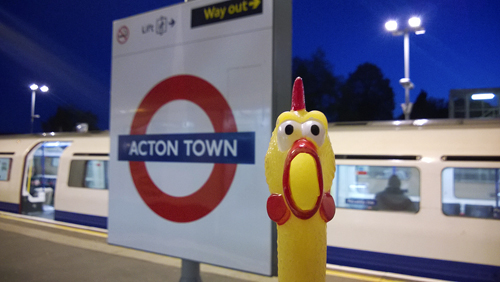
Acton Town was recorded as Acton(e) in 1181 and the name is derived from the Old English ac, ’oak’ and tun, ’a farm’ – meaning ’the farm by the oak tree(s)’. There was a busy little village in this area from the 16th century onwards developing into the town of Acton. It has been known as Church Acton to distinguish it from East Acton, formerly a separate hamlet.
The station was built as Mill Hill Park on 1 July 1879; rebuild with the name Mill Hill Park on 20 Feb 1910; but re-named Acton Town on 1 March 1910.
ALDGATE
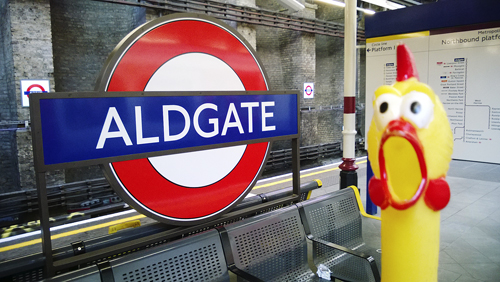
Aldgate is named after the gate which once spanned the road between Dukes Place and Jewry Street. The original gate was built by the Saxons and the name is derived from Aelgate – meaning ’open to all’ a free gate. It has been also interpreted as the old-gate but this is probably incorrect. Aldgate was one of the original four gates in the City Wall, rebuilt in 1609 but demolished in 1761.
The station was opened as Aldgate on 18 November 1876.
ALDGATE EAST
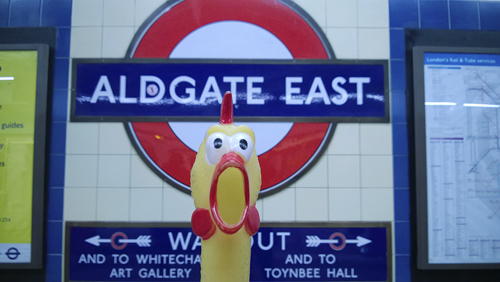
See Aldgate.
The proposed name of the original station was Commercial Road, but it opened as Aldgate East on 6 October 1884. The station was moved a short distance east in 1938.
ALPERTON
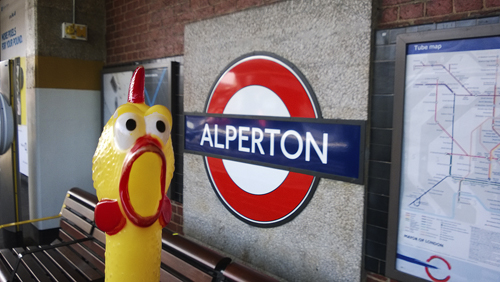
Alperton, originally Ealhberhington, was recorded as Alprinton in the 12th century and the name is derived from the personal name of the Saxon Ealhbeart and Old English tun, ’a farm’ – means ’the farm of Ealhbeart’ and his family who once lived on a site here. It is sometimes recorded that Alperton is derived from ’apple farm’, but this can be discounted. The name changed to Alperton in the course of time.
The station was opened as Perivale-Alperton on 28 June 1903 and re-named Alperton on 7 October 1910.
AMERSHAM
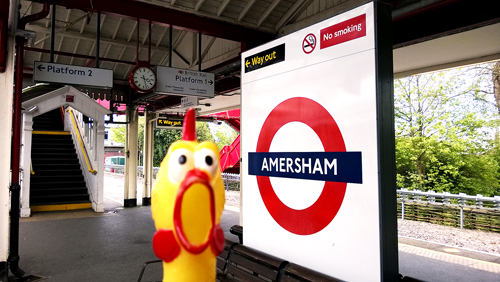
Amersham was recorded as Agmondesham in 1066 and the name is derived from the original wording Ealgmundsham, being the personal name of the Saxon Ealgmund, and Old English ham, ’a homestead’– ’the home of Ealgmund’ and his family who once lived a site here. Changed to Amersham c. 1675.
The station was opened as Amersham on 1 September 1892. It was renamed Amersham & Chesham Bois on 12 March 1922, reverting to Amersham in about 1934.
ANGEL

This district and road junction at the end of City Road takes its name from a once famous coaching inn that dates from at least 1638.
The Angel was one of the commonest mediaeval inn signs and in the mid-18th century there were 23 Angel Alleys and 30 Angel Courts in London. The building now stands empty and little noticed on the corner of Pentonville Road and Islington High Street. The only indication of its past history is Angel Mews, which runs behind the building.
The station was opened as Angel on 17 November 1901 and was completely rebuild in 1992 to cope with a much higher usage.
ARCHWAY
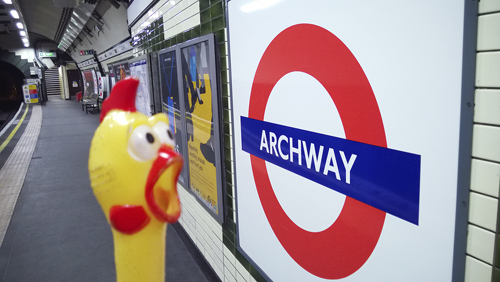
In 1813 the Archway Road was constructed to avoid the slope up to Highgate Hill. The viaduct was designed by Sir Alexander Binnie and built in 1897 over the road in place of the former Highgate Archway which was a short tunnel. The district is, therefore, known as Archway. Railings, seven feet high, were erected on the viaduct to discourage the many suicides that took place here, but the view is still spectacular.
The station was opened as Highgate on 22 June 1907, although Archway Tavern appears on at least one pre-opening map. With the building of the northern extension to form an interchange with Highgate LNER, Highgate South was considered before the name was changed to Archway (Highgate) on 11 June 1939, and Archway in December 1947.
ARNOS GROVE
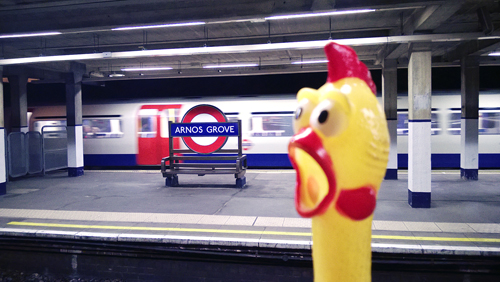
Arnos Grove was recorded as Arnold(e)s Grove in 1551 and it seems that the name should be associated with the 14th-century family of Margery Arnold who once lived in this area. The Grove itself runs to the north of the nearby Arnos Park.
The station’s name was planned to be Bowes Road, but it opened as Arnos Grove on 19 September 1932.
ARSENAL
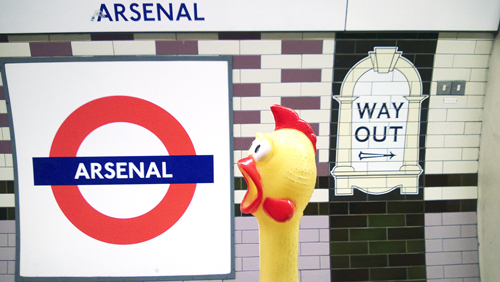
Arsenal takes its name from the famous Arsenal Football Club which moved here in 1913 from Woolwich where it had been founded at the Royal Arsenal Factory in 1884 – hence the nickname for the team: The Gunners.
The station was opened as Gillespie Road on 15 December 1906 and re-named Arsenal on 31 October 1932 at a pre-war height of the Club’s fame.
BAKER STREET
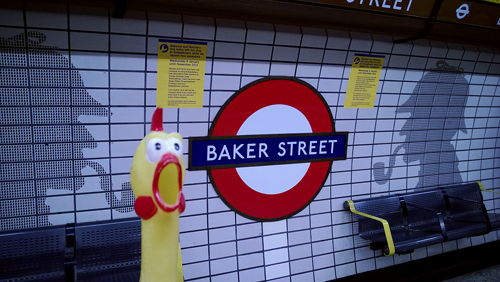
Baker Street was completed in 1799 and was named after either Sir Edward Baker of Ranston in Dorset who was the owner of an estate in the area, or more probably, William Baker who developed an estate after purchasing land from William Portman (who owned the whole area) in the eighteenth century. The street is, of course, associated with the famous fictional detective Sherlock Holmes ’who had rooms at 221b Baker Street’.
The Metropolitan Line station was opened as Baker Street on 10 January 1863, the ’extension’ line station opened on 13 April 1868, and the Bakerloo Line station on 10 March 1906.
BALHAM
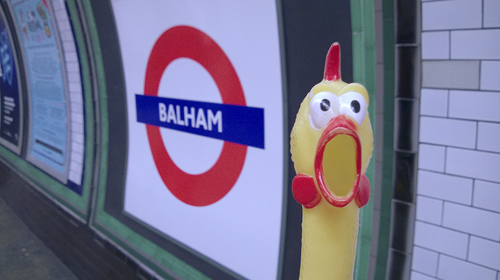
Balham was known as Baelenham in 957 and later as Baelganhamm being derived from the personal name of the Saxon Bealga, and Old English ham, ’a homestead’. It means ’the home of Bealga’ and his family who once lived on a site here. It was recorded as Balgaham in c. 1115.
The station was opened as Balham on 6 December 1926.
BANK

Bank takes its name from the Bank of England which was established in 1694 based on the proposals of William Paterson, a Scotsman. From 1964–1724 the business of the Bank was carried on at Mercers’ Hall, and then at Grocers’ Hall. In 1724 a site in Threadneedle Street was purchased; the building was erected in 1732–34 and rebuild in 1940.
Threadneedle Street was recorded in 1598 as Three needle Street; this probably refers to a tailor’s sign, for this area was once an enclave of tailors and drapers, or a children’s game ’threadneedle’, first noticed in 1751 but which may be two centuries older. There is no evidence that the street was ever the centre for the Needlemakers’ Company.
The Waterloo & City Railway was opened by the Duke of Cambridge on 11 July 1898 which was the 50th anniversary of the opening of the original Waterloo Station. The City Station was called City, although sometimes referred to as Mansion House. It was not re-named Bank until 28 October 1940. The Northern Line station was opened as Bank on 25 February 1900, Lombard Street having been its planned name at one stage, followed by the Central Line Bank station on 30 July 1900. The re-constructed station was opened on 5 May 1925.
BARBICAN

Barbican was called barbicana when a Roman Tower once stood just north of the street that now bears this name. Barbicana is Latin in origin and, in this turn, is probably from the Persian wording meaning ’upper chamber’. The Saxons named the tower burgh kennin — meaning ’town watchtower’, on which for many centuries fires were lit to guide travellers to their destinations across London. It seems the tower was pulled down in 1267 on the orders of Henry III but it was then rebuilt in 1336 on the orders of Edward III. The date when the tower was finally demolished is uncertain but it is known there was a house on the site in 1720. The area has been extensively re-developed since the Second World War as the Barbican Project.
The station was opened as Aldersgate Street on 23 December 1865; re-named Aldersgate & Barbican 1923, and Barbican on 1 December 1968.
BARKING
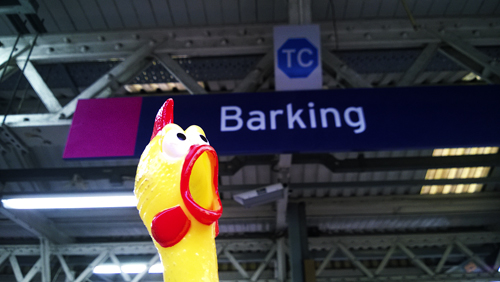
Barking was recorded as Berecingum in 735 and is probably named from the Saxon people the Bercia and the Old English place name word ending ing, literally ’the people who lived at ’. Barking, we can deduce, means – ’the home of the Bercias’. The area was divided in the various manors in the Middle Ages, one being Berengers, a variation on the original name. It is also possible that the name can be interpreted as ’the dwellers among the birch trees’ and, maybe, this referred to the Bercias.
The station was opened as Barking by the London, Tilbury & Southend Railway on 13 April 1854 and first used by Underground trains on 31 May 1902.
BARKINGSIDE
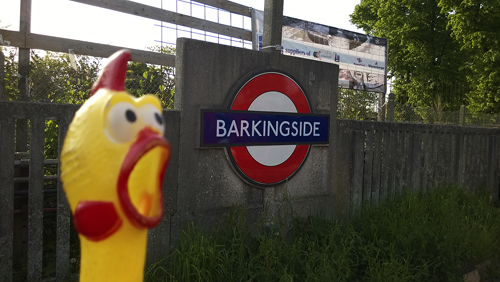
Barkingside was named in 1538 being on the extreme edge of the old parish of Barking. The word side is associated with a slope or hill especially one extending for a considerable distance which was no doubt the case during the 16th century.
The station was opened as Barkingside by the Great Eastern Railway on 1 May 1903 and first used by Underground trains on 31 May 1948.
BARONS COURT
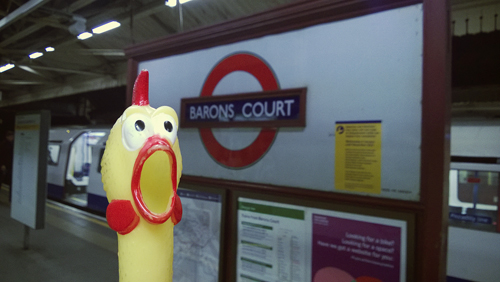
Unlike Earl’s Court this name has no connections with the law, or the nobility, but was so named after an estate that extends from the District Line to Perham Road to the south. The estate was planned by Sir William Palliser and built at the end of the 19th century. The name was fabricated perhaps in allusion to the title of Court Baron then held by the Lord of the Manor or because Earl’s Court was the name of the nearby district.
The station was opened as Barons Court on 9 October 1905.
BAYSWATER
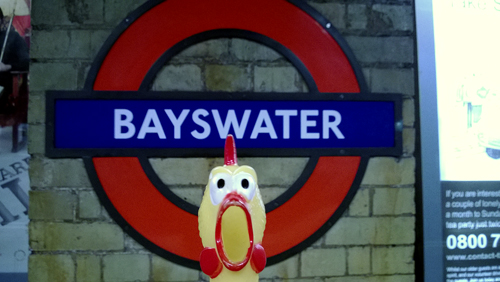
Bayswater was recorded as Bayard’s Watering in 1380 and has had many variant spellings before named as Bay(e)swater by 1659. The original Bayard’s Watering was the where the Westbourne Stream crossed the Oxford Road (now Bayswater Road) and is possibly derived from the Bayard family who once lived in this area.
The station was opened as Bayswater on 1 October 1868. Later known as Bayswater (Queen’s Road) and then Queen’s Road, Bayswater. Re-named Bayswater (Queen’s Road) & Westbourne Grove on 20 July 1922. Then name reverted to Bayswater in 1933.
BECONTREE
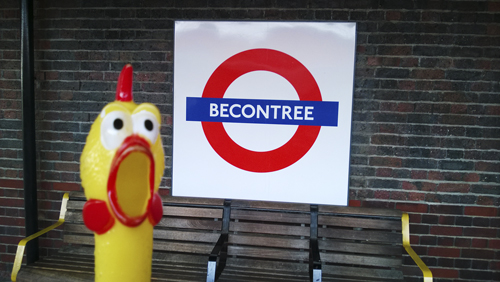
Becontree is thought to take its name from a local natural feature although associated with the Saxon people the Beohha who had an encampment by a distinctive tree, which was probably a boundary mark. It was recorded as Beuentreu in the Domesday Book. It is possible, however, that the name is from Old English, beacen-treo(w), ’beacon tree’ being an old meeting place.
The station was opened as Gale Street by the London Midland & Scottish Railway on 28 June 1926; re-named Becontree 18 July 1932. Used by Underground trains from 12 September 1932.
BELSIZE PARK
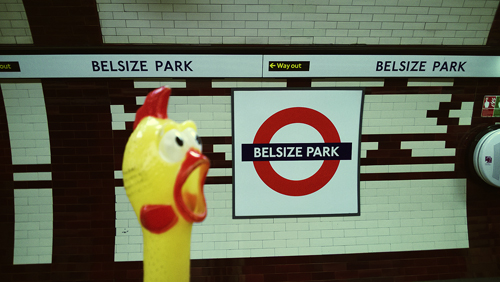
Belsize Park was recorded as Balassis in 1317 from the Old French wording bel asis, which means ’beautifully situated’, and was no doubt aptly named from the manor house and park which were once on the present site of Belsize Square. No fewer than ten streets in this part of north west London include Belsize in their name.
Before the station opened plain Belsize was considered for the name, but it was opened as Belsize Park on 22 June 1907.
BERMONDSEY

Bermondsey was recorded as Vermudesi c. 712 and as Bermundesy in the Domesday Book and the name is derived from the Saxon lord of the district, Beormund and his family who lived here and the Old English Eg – ’an island’ (or marsh) – ’Beormunds island’. The name changed to its present spelling over time.
The station opened as Bermondsey on 17 September 1999.
BETHNAL GREEN
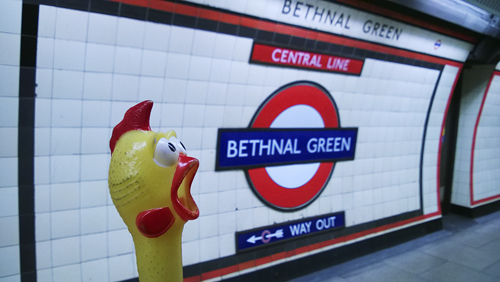
Blithehale was the recorded name for this district during the 13th century. The second element hale means – ’an angle or corner of land’. Maybe Blithe is a corruption of the personal name Blida, a family who resided here in the reign of Edward I (1272–1307), or perhaps refers to an ancient stream of this area called Bythe. The ’village green at Bathon’s river meadow’ could be the complete meaning of the name. It has had many changes or spelling until recorded as Bethnal Green in 1657. On what remains of the Green now stand St John’s Church (built in 1825–28), the Bethnal Green Museum and the local public gardens.
The committee of the New Works Programme 1935/40 considered the name Bethnal to avoid confusion with the London North Eastern Railway station of Bethnal Green Junction although when the station opened as Bethnal Green on 4 December 1946 the LNER had adopted the same name for their own station.
BLACKFRIARS
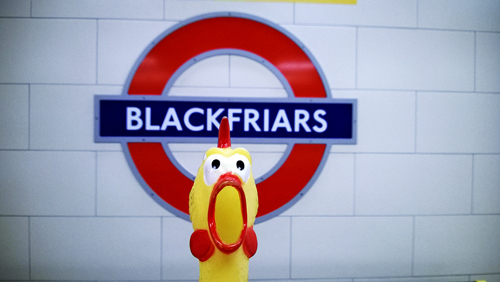
This area takes its name from the colour of the habits worn by the friars of a Dominican monastery who were known as Black Friars. The monastery was established during the 13th century by the Earl of Kent, but was closed on the orders of Henry VIII in 1538. Part of the building later became the Blackfriars Theatre which was pulled down in 1665.
The station is built on the site of Chatham Place which was named in honour of William Pitt, 1st Earl of Chatham. The station was opened as Blackfriars on 30 May 1870.
BLACKHORSE ROAD
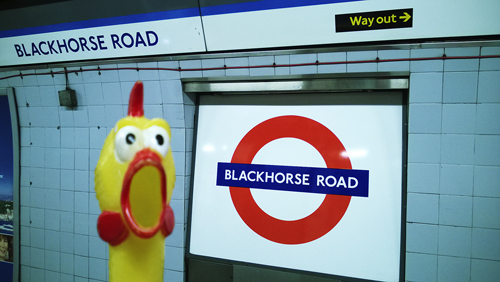
Blackhorse Road was recorded as Black House Lane in 1848 which is the correct spelling, for the road takes its name from an old Black House, being on the site of an old Clock House. Changed to Blackhorse Lane (then road) at a later date, this change has some connection with the east London dialect.
The station was opened as Blackhorse Road on 1 September 1968.
BOND STREET
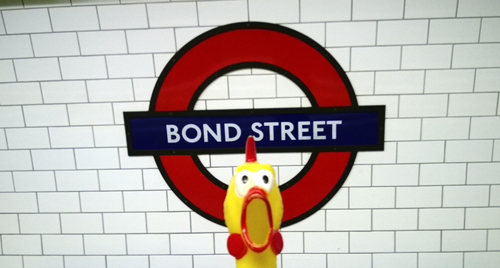
Bond Street was laid out in 1686 to designs by Sir Thomas Bond, Comptroller of the Household of Queen Henrietta Maria (The Queen Mother), and is named after him, although he died in 1685. The street is now renowned for its fashionable shops and picture dealers’ galleries. The south portion of the street is known as Old Bond Street, being re-named in 1734, while the north portion running to Oxford Street is known as New Bond Street, named in 1732.
Before the station opened, the name Davies Street was proposed, but it opened as Bond Street on 24 September 1900.
BOROUGH
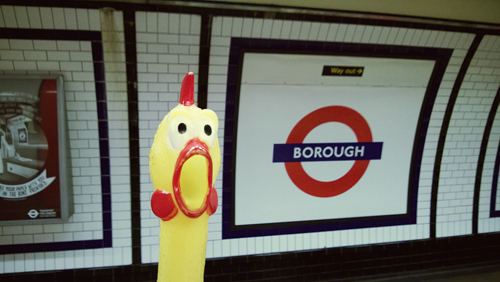
This district is part of ancient London, for here the Romans founded a settlement and built a ’high street’ as an approach to London Bridge. The Borough is a small part of Southwark and although the word borough means ’a fortified place’ (Old English burh) the word now has another definition. It also refers to a town with its own local government, for in the late Middle Ages this was the only London Borough both outside the City Wall and sending its own Member to Parliament. It has kept its name ever since.
The station was opened an Borough on 18 December 1890.
BOSTON MANOR
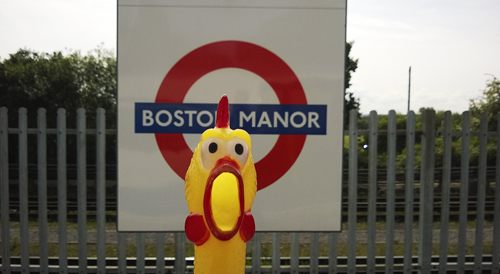
This Boston has not connection with its more famous namesakes in Lincolnshire or the USA. Known during the 14th century as Bordeston from Bords (a personal name) and the Old English tun, ’a farm’ – means ’Bords farm’, which in its turn has been corrupted to Burston, then Boston during the 16th century. The Manor originally belonged to the convent of St Helen’s Bishopsgate and its ownership has changed hands many times during the course of history. Boston Manor is noted for its Tudor and Jacobean Mansion – ’Boston House’.
The station was opened on 1 May 1883 as Boston Road, re-named Boston Manor on 11 December 1911, and the rebuilt station was completed 25 March 1934.
BOUNDS GREEN
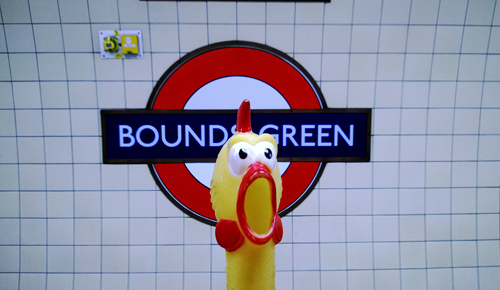
Bounds Green is a district of North London whose name is derived from its association with the families of John le Bonde in 1294 and Walter le Bounde during the 13th century and being recorded as le Boundes in 1365. Bounds Green is the modern version of the name. Nothing is left of the Green, the area now occupied by the Bounds Green Road.
Prior to the opening of the station the name of Brownlow Road was proposed, but it opened as Bounds Green on 19 September 1932.
BOW ROAD
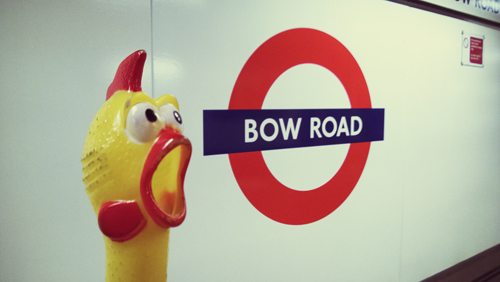
This main road is so called from an arched (’bow’) bridge built over the River Lea in the 12th century; or from the bow (or bend) in the road to the east of the station, which can still be seen just to the west of the modern fly-over.
The station was opened as Bow Road on 11 June 1902.
BRENT CROSS
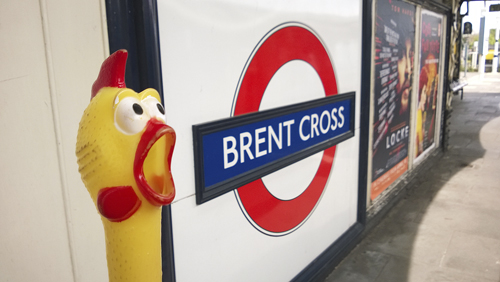
Brent Cross takes its name from the nearby river that joins the Thames at Brentford and was recorded as Braegente in 959. In its turn the river-name is derived from the hypothetical Old English Brigantiga, probably meaning the holy or high river and as the river flows mostly through low country the former is more likely. The name became Brent(e) by the 13th century.
The station was originally proposed to have been named Woodstock, but it was opened as Brent on 19 November 1923 and re-named Brent Cross on 20 July 1976.
BRIXTON
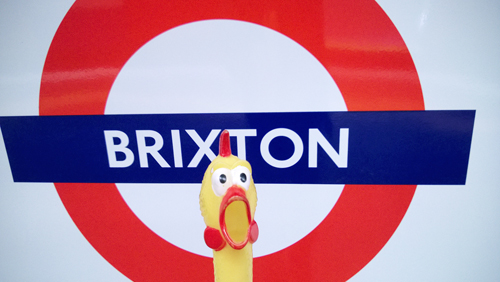
Brixton is recorded as brixges stane in 1062, and as Brixistan in the Domesday Book. The name is derived from the personal name of the Saxon Beorhtric and the Old English stane, ’stone’. Stones were often used as meeting points. The name changed to Brixton in the course of time.
The station was opened as Brixton on 23 July 1971.
BROMLEY-by-BOW
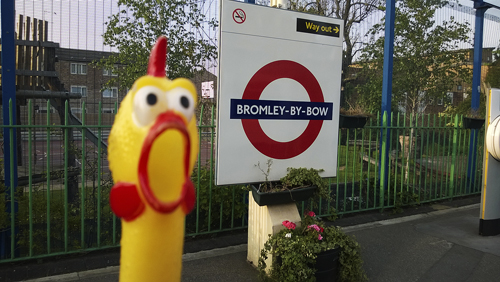
Bromley was recorded as Braembelege in 1000, Brambeley in 1128 and is derived from the Old English broom (tree) and leah, ’a forest’. The main road (Bow Road) is so called from an arched (’bow’) bridge built over the River Lea in the 12th century; or from the bow (or bend) in the road.
The station was opened by the London, Tilbury & Southend Railway on 31 March 1858 as Bromley. It was first used by Underground trains on 2 June 1902 and was re-named Bromley-by-Bow on 5 May 1968.
BUCKHURST HILL
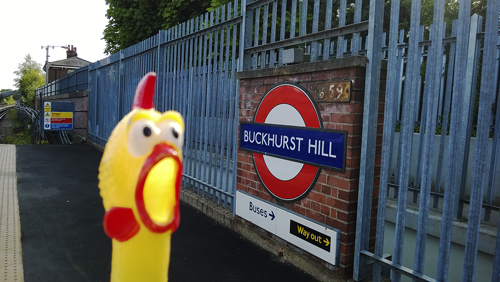
As the name suggests, Buckhurst Hill takes its name from a local natural feature, recorded as Bocherst(e) in 1135 from the Old English beech (tree) and hyrst, ’a copse’ or ’wood’ – later to be called Buckhurst. The area has also been called Goldhurst, the ’gold’ referring no doubt o the colour of the trees in the wood. The Hill refers to another nearby feature.
The station was opened as Buckhurst Hill by the Eastern Counties Railway on 22 August 1856 and first used by Underground trains on 21 November 1948.
BURNT OAK
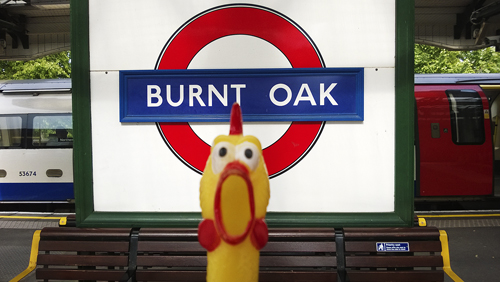
Tradition has it that the Romans had a site near here which they used as a boundary mark where fires were lit as a guide – so a burnt oak.
Prior to the opening of the station the name Sheaves Hill was proposed. This was not liked by Hendon Urban District Council, who suggested Burnt Oak, Orange Hill or Deansbrook. The station was opened as Burnt Oak on 27 October 1924.

